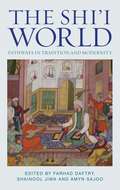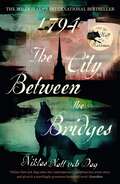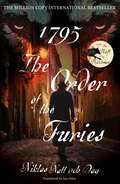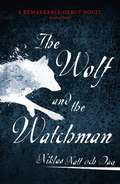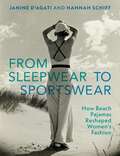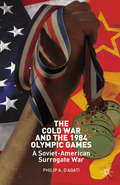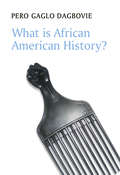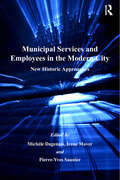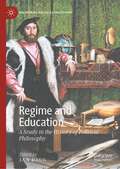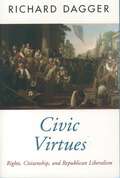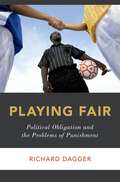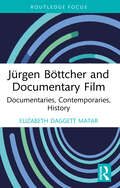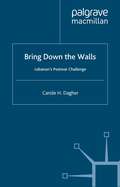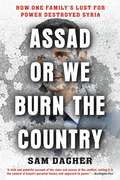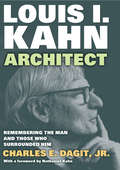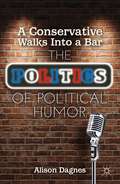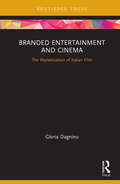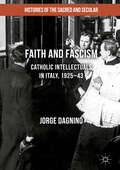- Table View
- List View
The Shi'i World: Pathways in Tradition and Modernity (Muslim Heritage)
by Farhad Daftary Amyn B. Sajoo Shainool JiwaThe world's 200 million Shi'i Muslims express their faith in a multiplicity of ways, united by reverence for the ahl al-bayt, the family of the Prophet. In embracing a pluralistic ethic, fourteen centuries of Shi'i Islam have given rise to diverse traditions and practices across varied geographic and cultural landscapes. The Shi'i World is a comprehensive work authored by leading scholars from assorted disciplines, to provide a better understanding of how Shi'i communities view themselves and articulate their teachings. The topics range from Shi'i Islam's historical and conceptual foundations, formative figures and intellectual, legal and moral traditions, to its devotional practices, art and architecture, literature, music and cinema, as well as expressions and experiences of modernity. The book thus provides a panoramic perspective of the richly textured narratives that have shaped the social and moral universe of Shi'i Muslims around the globe. This fourth volume in the Muslim Heritage Series will appeal to specialists and general readers alike, as a timely resource on the prevailing complexities not only of the 'Muslim world', but also of the dynamic Shi'i diasporas of Europe and North America.
1794: The Million Copy International Bestseller (Jean Mickel Cardell #2)
by Niklas Natt Dag#1 bestseller in Sweden with over 1.5 million copies sold'Niklas Natt och Dag takes the contemporary Scandinavian crime story and gives it a startlingly gruesome historical twist' GuardianThe year is 1794. A young nobleman, Eric Three Roses, languishes in hospital. Some think he would be just at home in the madhouse across the road. Ridden with guilt, he spends his nights writing down memories of his lost love who died on their wedding night. Her mother also mourns her and when no one listens to her suspicions, she begs the aid of the only person who will listen: Jean Mickel Cardell, the one-armed watchman.Cecil Winge is six months in the ground but when his younger brother Emil seeks out the watchman to retrieve his brother's missing pocket watch, Cardell enlists his help to discover what really happened at Three Roses' estate that night. But, unlike his dead brother, the younger Winge is an enigma, and Cardell soon realises that he may be more hindrance than help. And when they discover that a mysterious slave trader has been running Three Roses' affairs, it is a race against time to discover the truth before it's too late.In 1794, the second installment of Niklas Natt och Dag's historical noir trilogy, we are reunited with Mickel Cardell, Anna Stina Knapp, and the bustling world of late eighteenth century Stockholm from The Wolf and the Watchman. The city is about to see its darkest days yet as veneers crack and the splendour of old gives way to what is hiding in the city's nooks and crannies.
1795: The Order of the Furies (Jean Mickel Cardell #3)
by Niklas Natt Dag'Niklas Natt och Dag takes the contemporary Scandinavian crime story and gives it a startlingly gruesome historical twist' GuardianIt is 1795 and evil lurks in the winding alleys of Stockholm. Tycho Ceton prowls the city, willing to do anything to survive and reclaim the honour he has lost. No one knows what he is planning next but Emil Winge, haunted by the ghosts of his past, is determined to stop him. Meanwhile, Jean Mickel Cardell is preoccupied with his own search for Anna Stina Knapp. She may have in her possession a letter which could have devastating consequences in the wrong hands.All the while, hell looms inexorably . . .In 1795: The Order of the Furies, the third instalment of Niklas Natt och Dag's historical noir trilogy, we are plunged once again into the bustling world of late eighteenth-century Stockholm. The city is teetering on a precipice, with evil shaking its core, but can love and friendship prevail?Translated by Ian Giles
The Wolf and the Watchman: The latest Scandi sensation
by Niklas Natt Dag'A remarkable debut novel' Sunday Times'The best historical thriller I've read in twenty years' A.J. Finn'A thrilling, unnerving, clever and beautiful story. Reading it is like giving a little gift to oneself' Fredrik BackmanThe year is 1793, Stockholm. King Gustav of Sweden has been assassinated, years of foreign wars have emptied the treasuries, and the realm is governed by a self-interested elite, leaving its citizens to suffer. On the streets, malcontent and paranoia abound.A body is found in the city's swamp by a watchman, Mickel Cardell, and the case is handed over to investigator Cecil Winge, who is dying of consumption. Together, Winge and Cardell become embroiled in a brutal world of guttersnipes and thieves, mercenaries and madams, and one death will expose a city rotten with corruption beneath its powdered and painted veneer.The Wolf and the Watchman depicts the capacity for cruelty in the name of survival or greed - but also the capacity for love, friendship, and the desire for a better world.'An unexpected masterpiece, a wild and unusual mix of genres that in one fell swoop succeeds in renewing the entire crime fiction genre' Arne Dahl
From Sleepwear to Sportswear: How Beach Pajamas Reshaped Women's Fashion
by Janine D'Agati Hannah SchiffHow did women begin wearing pants? Prior to the 1920s it was a rarity to see women in pants in the Western world, but as the silk pajama trouser suit moved from the boudoir to the beach in the early 1920s it cemented the image of the trousered woman.Worn by Jean Harlow and Marlene Dietrich, painted by Raoul Dufy and immortalized in F. Scott Fitzgerald's Tender is the Night, between the two world wars pajamas came to symbolize much more than sleepwear. This book explores how the pajama phenomenon was not only critical to the careers of designers such as Chanel, Patou, Poiret, and Schiaparelli, but how the versatile garment was also bound to the independence of women and influenced culture more broadly.Through meticulous research and never-before-seen images, the authors position pajama fashion in the context of the Golden Age of Travel, the rise of Hollywood, and the changing political climate of the early 20th century, to reveal how the rising trend in sleepwear influenced The American Look, modern sportswear, and the image of the trousered woman.
The Cold War and the 1984 Olympic Games: A Soviet-American Surrogate War
by Philip D’AgatiThe Soviet boycott of the 1984 Olympic Games is explained as the result of a complex series of events and policies that culminated in a strategic decision to not participate in Los Angeles. Using IR framework, D'Agati developes and argues for the concept of surrogate wars as an alternative means for conflict between states.
What is African American History? (What is History?)
by Pero Gaglo DagbovieScholarship on African American history has changed dramatically since the publication of George Washington Williams’ pioneering A History of the Negro Race in America in 1882. Organized chronologically and thematically, What is African American History? offers a concise and compelling introduction to the field of African American history as well as the black historical enterpriseÑpast, present, and future. Pero Gaglo Dagbovie discusses many of the discipline’s important turning points, subspecialties, defining characteristics, debates, texts, and scholars. The author explores the growth and maturation of scholarship on African American history from late nineteenth and early twentieth centuries until the field achieved significant recognition from the ‘mainstream’ U.S. historical profession in the 1970s. Subsequent decades witnessed the emergence and development of key theoretical approaches, controversies, and dynamic areas of concentration in black history, the vibrant field of black women’s history, the intriguing relationship between African American history and Black Studies, and the imaginable future directions of African American history in the twenty-first century. What is African American History? will be a practical introduction for all students of African American history and Black Studies.
What is African American History? (What is History?)
by Pero Gaglo DagbovieScholarship on African American history has changed dramatically since the publication of George Washington Williams’ pioneering A History of the Negro Race in America in 1882. Organized chronologically and thematically, What is African American History? offers a concise and compelling introduction to the field of African American history as well as the black historical enterpriseÑpast, present, and future. Pero Gaglo Dagbovie discusses many of the discipline’s important turning points, subspecialties, defining characteristics, debates, texts, and scholars. The author explores the growth and maturation of scholarship on African American history from late nineteenth and early twentieth centuries until the field achieved significant recognition from the ‘mainstream’ U.S. historical profession in the 1970s. Subsequent decades witnessed the emergence and development of key theoretical approaches, controversies, and dynamic areas of concentration in black history, the vibrant field of black women’s history, the intriguing relationship between African American history and Black Studies, and the imaginable future directions of African American history in the twenty-first century. What is African American History? will be a practical introduction for all students of African American history and Black Studies.
Municipal Services and Employees in the Modern City: New Historic Approaches
by Michèle Dagenais Irene MaverMunicipal Services and Employees in the Modern City considers the roles played by local institutions and particular processes that shaped the urban fabric. It rediscovers from models and maps the constituent dynamics of cities since the beginning of the nineteenth century, and demonstrates how patterns evolved in the way services and locations were organized; how urban transformation was underpinned by structural development, and how the municipal workforce became an integral part of the agencies of change. Municipal Services and Employees in the Modern City suggests that municipal experiences are central to the development of urban studies. Its focus of analysis ranges across Europe and the Americas from high-ranking bureaucrats to firefighters, engineers to accountants, and town clerks to public servants. Each essay provides detailed information on how change was formulated or resisted within the administrative apparatus, offering insight into a sector of the 'white-collar' class and the degree of commitment to public values often at times of social and political upheaval. They explore the course of relationships between local and central government, and the shifting bounds of municipal interventionism over a broad period; whilst incorporating a social history approach to interpret the day-to-day responsibilities and routine of administration.
Municipal Services and Employees in the Modern City: New Historic Approaches
by Michèle Dagenais Irene MaverMunicipal Services and Employees in the Modern City considers the roles played by local institutions and particular processes that shaped the urban fabric. It rediscovers from models and maps the constituent dynamics of cities since the beginning of the nineteenth century, and demonstrates how patterns evolved in the way services and locations were organized; how urban transformation was underpinned by structural development, and how the municipal workforce became an integral part of the agencies of change. Municipal Services and Employees in the Modern City suggests that municipal experiences are central to the development of urban studies. Its focus of analysis ranges across Europe and the Americas from high-ranking bureaucrats to firefighters, engineers to accountants, and town clerks to public servants. Each essay provides detailed information on how change was formulated or resisted within the administrative apparatus, offering insight into a sector of the 'white-collar' class and the degree of commitment to public values often at times of social and political upheaval. They explore the course of relationships between local and central government, and the shifting bounds of municipal interventionism over a broad period; whilst incorporating a social history approach to interpret the day-to-day responsibilities and routine of administration.
Regime and Education: A Study in the History of Political Philosophy (Recovering Political Philosophy)
by Ian DaggThis volume is an inquiry into the history of political philosophy by way of the general theme of education. Each contributor addresses the relationship between a particular political philosopher’s broad teaching on the best political order and that political philosopher’s teaching about education. The unifying contention of the work is that each political philosopher considered in the volume promotes a certain kind of political regime and therefore a particular mode of education essential to that regime. Each chapter, written by a separate contributor, is distinguished from the others primarily by the political philosopher being considered. The book has a chapter dedicated to each of the following political philosophers: Plato, Xenophon, Aristotle, Machiavelli, Bacon, Locke, Rousseau, Tocqueville, and Nietzsche. The volume provides a survey of educational models by some of the greatest thinkers of the West, while continually demonstrating that the two themes of politics and education are inseparable.
Civic Virtues: Rights, Citizenship, and Republican Liberalism (Oxford Political Theory)
by Richard Dagger"The book is beautifully written, elegantly organised and it achieves with splendid efficiency all of the goals that it sets for itself. I recommend it warmly."--Mind "Dagger's book makes a very important contribution to our understanding of citizenship through its clear demonstration that state promotion of civic virtue is compatible with individual autonomy."--Political Studies
Playing Fair: Political Obligation and the Problems of Punishment (Studies in Penal Theory and Philosophy)
by Richard DaggerWhile much has been written on both political obligation and the justification of punishment, there has been little sustained effort to link the two. In Playing Fair, Richard Dagger aims to fill this gap and provide a unified theory of political obligation and the justification of punishment that takes its bearings from the principle of fair play. To do this, he first establishes the principle of fair play-the idea that people in a cooperative venture have obligations to one another to shoulder a fair share of the burdens because they receive a fair share of the benefits of cooperation-as the basis of political obligation. Dagger then argues that the members of a reasonably just polity have an obligation to obey its laws because they have an obligation of reciprocity, or fair play, to one another. This theory of political obligation provides answers to fundamental and still debated questions about how to justify punishment, who has the right to carry it out, and how much to punish. Playing Fair brings two long-standing concerns of political and legal philosophy together to rebut those who deny the possibility of a general obligation to obey the law, to defend the link between political authority and obligation, and to establish the proper scope of criminal law.
Playing Fair: Political Obligation and the Problems of Punishment (Studies in Penal Theory and Philosophy)
by Richard DaggerWhile much has been written on both political obligation and the justification of punishment, there has been little sustained effort to link the two. In Playing Fair, Richard Dagger aims to fill this gap and provide a unified theory of political obligation and the justification of punishment that takes its bearings from the principle of fair play. To do this, he first establishes the principle of fair play-the idea that people in a cooperative venture have obligations to one another to shoulder a fair share of the burdens because they receive a fair share of the benefits of cooperation-as the basis of political obligation. Dagger then argues that the members of a reasonably just polity have an obligation to obey its laws because they have an obligation of reciprocity, or fair play, to one another. This theory of political obligation provides answers to fundamental and still debated questions about how to justify punishment, who has the right to carry it out, and how much to punish. Playing Fair brings two long-standing concerns of political and legal philosophy together to rebut those who deny the possibility of a general obligation to obey the law, to defend the link between political authority and obligation, and to establish the proper scope of criminal law.
Jürgen Böttcher and Documentary Film: Documentaries, Contemporaries, History (Routledge Focus on Film Studies)
by Elizabeth Daggett MatarJürgen Böttcher and Documentary Film introduces the reader to this east-German filmmaker who, despite having made 40 films from the east side of the Berlin Wall, is practically unknown. Through the comparison of films made in the same year, one by an American and one by Böttcher, the author places him as ahead of his time in regards to technology, content, and style, and neck-and-neck with contemporary American filmmakers in cinéma vérité/direct cinema. The book moves beyond Böttcher’s dramatic biography to explore his role in the history of film. Was it actually the Germans who created sync sound for documentary? When and how were women featured? Offering a concise journey through the history of documentary film within this cultural context, but also a deep-dive into specific case-studies that show the nuances and complexities of classifying film texts, this volume will interest students and scholars of film studies, German cinema, cinéma vérité, film production, film theory, and world cinema.
Jürgen Böttcher and Documentary Film: Documentaries, Contemporaries, History (Routledge Focus on Film Studies)
by Elizabeth Daggett MatarJürgen Böttcher and Documentary Film introduces the reader to this east-German filmmaker who, despite having made 40 films from the east side of the Berlin Wall, is practically unknown. Through the comparison of films made in the same year, one by an American and one by Böttcher, the author places him as ahead of his time in regards to technology, content, and style, and neck-and-neck with contemporary American filmmakers in cinéma vérité/direct cinema. The book moves beyond Böttcher’s dramatic biography to explore his role in the history of film. Was it actually the Germans who created sync sound for documentary? When and how were women featured? Offering a concise journey through the history of documentary film within this cultural context, but also a deep-dive into specific case-studies that show the nuances and complexities of classifying film texts, this volume will interest students and scholars of film studies, German cinema, cinéma vérité, film production, film theory, and world cinema.
Bring Down the Walls: Lebanon's Post-War Challenge
by C. DagherLebanon is more than a country, it is a message': these words of Pope John Paul II illustrate Lebanon's post-war endeavor to preserve its age-old Christian-Muslim coexistence and power-sharing formula and to invalidate Samuel Huntington's assumption of a 'Clash of Civilizations.' Lebanon's current challenge is also the challenge of a whole region, the Middle East, where the fate of minorities, including Eastern Christians, reveals the prospects of democracy, pluralism and political participation. Carole H. Dagher, a journalist for Lebanese media as well as an academic, presents an insightful account on how Christian and Muslim communities emerged from the sixteen year-old Lebanese war, what their points of friction and their common grounds are, and what the prospects of Lebanon's communal representation system and pluralistic society are. She describes the central role played by the Holy See and John Paul II in bridging the gap between Christians and Muslims in Lebanon, and analyzes the impact other countries such as Syria, Iran and Saudi Arabia have had on the power game and, conversely, the impact of Christian-Muslim interaction on the future of the Arab-Israeli peace process. Bring Down the Walls draws crucial lessons from the recent history of Christian-Muslim relations in Lebanon.
Assad or We Burn the Country: How One Family's Lust for Power Destroyed Syria
by Sam DagherFrom a Pulitzer Prize-nominated journalist specializing in the Middle East, this groundbreaking account of the Syrian Civil War reveals the never-before-published true story of a 21st-century humanitarian disaster. In spring 2011, Syrian President Bashar al-Assad turned to his friend and army commander, Manaf Tlass, for advice about how to respond to Arab Spring-inspired protests. Tlass pushed for conciliation but Assad decided to crush the uprising -- an act which would catapult the country into an eight-year long war, killing almost half a million and fueling terrorism and a global refugee crisis. Assad or We Burn the Country examines Syria's tragedy through the generational saga of the Assad and Tlass families, once deeply intertwined and now estranged in Bashar's bloody quest to preserve his father's inheritance. By drawing on his own reporting experience in Damascus and exclusive interviews with Tlass, Dagher takes readers within palace walls to reveal the family behind the destruction of a country and the chaos of an entire region. Dagher shows how one of the world's most vicious police states came to be and explains how a regional conflict extended globally, engulfing the Middle East and pitting the United States and Russia against one another. Timely, propulsive, and expertly reported, Assad or We Burn the Country is the definitive account of this global crisis, going far beyond the news story that has dominated headlines for years.
Assad or We Burn the Country: How One Family's Lust for Power Destroyed Syria
by Sam DagherFrom a Pulitzer Prize-nominated journalist specializing in the Middle East, this groundbreaking account of the Syrian Civil War reveals the never-before-published true story of a 21st-century humanitarian disaster. In spring 2011, Syrian President Bashar al-Assad turned to his friend and army commander, Manaf Tlass, for advice about how to respond to Arab Spring-inspired protests. Tlass pushed for conciliation but Assad decided to crush the uprising -- an act which would catapult the country into an eight-year long war, killing almost half a million and fueling terrorism and a global refugee crisis. Assad or We Burn the Country examines Syria's tragedy through the generational saga of the Assad and Tlass families, once deeply intertwined and now estranged in Bashar's bloody quest to preserve his father's inheritance. By drawing on his own reporting experience in Damascus and exclusive interviews with Tlass, Dagher takes readers within palace walls to reveal the family behind the destruction of a country and the chaos of an entire region. Dagher shows how one of the world's most vicious police states came to be and explains how a regional conflict extended globally, engulfing the Middle East and pitting the United States and Russia against one another. Timely, propulsive, and expertly reported, Assad or We Burn the Country is the definitive account of this global crisis, going far beyond the news story that has dominated headlines for years.
Louis I. KahnArchitect: Remembering the Man and Those Who Surrounded Him
by Jr. Charles DagitFew people in the history of art and architecture have planted a seed of inspiration that grew to become a towering oak of lasting influence. There are those, particularly colleagues and students of Louis I. Kahn, who would say that he was one of these people. Certainly Kahn was one of the foremost architects of the twentieth century, designing such famous landmarks as the National Assembly Building in Dhaka, Bangladesh; the Salk Institute in La Jolla, California; and the Kimbell Museum in Fort Worth, Texas. In this commemorative volume, Charles E. Dagit, Jr. shows the power and influence that Kahn displayed at the University of Pennsylvania department of architecture in the 1960s. Since Dagit knew Kahn personally, this is a factual history as well as a glimpse into Kahn's personal wisdom and humanity. Beginning with a prelude that starts with the author's undergraduate years at the University of Pennsylvania, Dagit launches readers on an intellectual journey of how he first met Kahn. From there he details his experiences with Kahn and explores Kahn's interactions with Penn faculty members, including Mario Romanach, Robert Le Ricolet and Aldo Giurgola. This first-hand account sheds fascinating new light on one of the most prominent architects of the twentieth century.
Louis I. KahnArchitect: Remembering the Man and Those Who Surrounded Him
by Jr. Charles DagitFew people in the history of art and architecture have planted a seed of inspiration that grew to become a towering oak of lasting influence. There are those, particularly colleagues and students of Louis I. Kahn, who would say that he was one of these people. Certainly Kahn was one of the foremost architects of the twentieth century, designing such famous landmarks as the National Assembly Building in Dhaka, Bangladesh; the Salk Institute in La Jolla, California; and the Kimbell Museum in Fort Worth, Texas. In this commemorative volume, Charles E. Dagit, Jr. shows the power and influence that Kahn displayed at the University of Pennsylvania department of architecture in the 1960s. Since Dagit knew Kahn personally, this is a factual history as well as a glimpse into Kahn's personal wisdom and humanity. Beginning with a prelude that starts with the author's undergraduate years at the University of Pennsylvania, Dagit launches readers on an intellectual journey of how he first met Kahn. From there he details his experiences with Kahn and explores Kahn's interactions with Penn faculty members, including Mario Romanach, Robert Le Ricolet and Aldo Giurgola. This first-hand account sheds fascinating new light on one of the most prominent architects of the twentieth century.
A Conservative Walks Into a Bar: The Politics of Political Humor
by A. DagnesConservative critics argue that modern political satire, in the age of The Daily Show, has a liberal bias. A quick review of the humor landscape shows that there are very few conservative political satirists, and using personal interviews with political humorists this book explains why. The book explores the history of satire, the comedy profession, and the nature of satire itself to examine why there is an ideological imbalance in political humor and it explores the consequences of this disparity. This book will appeal to Daily Show and Colbert fans, political junkies, and anyone interested in the intersection of politics and media.
Branded Entertainment and Cinema: The Marketisation of Italian Film (Routledge Critical Advertising Studies)
by Gloria DagninoThe history of Italian cinema is mostly regarded as a history of Italian auteurs. This book takes a different standpoint, looking at Italian cinema from the perspective of an unusual, but influential actor: advertisers. From the iconic Vespa scooter and the many other Made in Italy products placed in domestic and international features, to Carosello’s early format of branded entertainment, up through the more recent brand integration cases in award-winning titles like The Great Beauty, the Italian film and advertising industries have frequently and significantly intersected, in ways that remain largely unexplored by academic research. This book contributes to fill this gap, by focusing on the economic and cultural influence that advertising and advertisers’ interests have been exerting on Italian film production between the post-war period and the 2010s. Increasingly market-oriented film policies, ongoing pressure from Hollywood competition, and the abnormal economic as well as political power held by Italian ad-funded broadcasters are among the key points addressed by the book. In addition to a macro-level political economic analysis, the book draws on exclusive interviews with film producers and promotional intermediaries to provide a meso level analysis of the practices and professional cultures of those working at the intersection of Italian film and advertising industries. Providing an in-depth yet clear and accessible overview of the political and economic dynamics driving the Italian media landscape towards unprecedented forms of marketisation, this is a valuable resource for academics and students in the fields of film and media studies, marketing, advertising, and Italian studies.
Branded Entertainment and Cinema: The Marketisation of Italian Film (Routledge Critical Advertising Studies)
by Gloria DagninoThe history of Italian cinema is mostly regarded as a history of Italian auteurs. This book takes a different standpoint, looking at Italian cinema from the perspective of an unusual, but influential actor: advertisers. From the iconic Vespa scooter and the many other Made in Italy products placed in domestic and international features, to Carosello’s early format of branded entertainment, up through the more recent brand integration cases in award-winning titles like The Great Beauty, the Italian film and advertising industries have frequently and significantly intersected, in ways that remain largely unexplored by academic research. This book contributes to fill this gap, by focusing on the economic and cultural influence that advertising and advertisers’ interests have been exerting on Italian film production between the post-war period and the 2010s. Increasingly market-oriented film policies, ongoing pressure from Hollywood competition, and the abnormal economic as well as political power held by Italian ad-funded broadcasters are among the key points addressed by the book. In addition to a macro-level political economic analysis, the book draws on exclusive interviews with film producers and promotional intermediaries to provide a meso level analysis of the practices and professional cultures of those working at the intersection of Italian film and advertising industries. Providing an in-depth yet clear and accessible overview of the political and economic dynamics driving the Italian media landscape towards unprecedented forms of marketisation, this is a valuable resource for academics and students in the fields of film and media studies, marketing, advertising, and Italian studies.
Faith and Fascism: Catholic Intellectuals in Italy, 1925–43 (Histories of the Sacred and Secular, 1700–2000)
by Jorge DagninoThis is a study of the Federazione Universitaria Cattolica Italiana (FUCI) between 1925 and 1943, the organisation of Catholic Action for the university sector. The FUCI is highly significant to the study of Catholic politics and intellectual ideas, as a large proportion of the future Christian Democrats who ruled the country after World War II were formed within the ranks of the federation. In broader terms, this is a contribution to the historiography of Fascist Italy and of Catholic politics and mentalities in Europe in the mid- twentieth century. It sets out to prove the fundamental ideological, political, social and cultural influences of Catholicism on the making of modern Italy and how it was inextricably linked to more secular forces in the shaping of the nation and the challenges faced by an emerging mass society. Furthermore, the book explores the influence exercised by Catholicism on European attitudes towards modernisation and modernity, and how Catholicism has often led the way in the search for a religious alternative modernity that could countervail the perceived deleterious effects of the Western liberal version of modernity.
